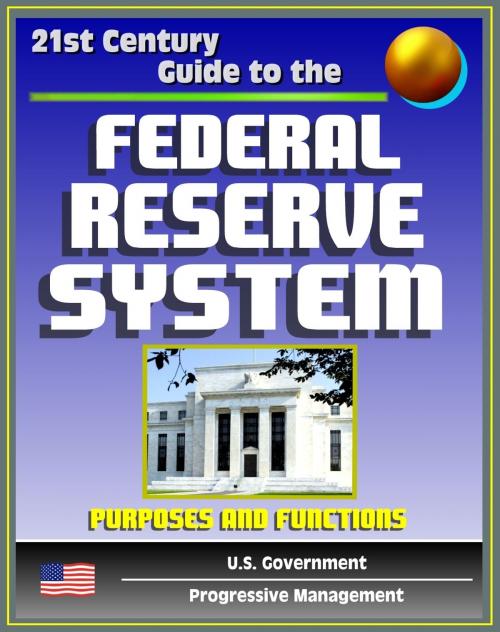21st Century Guide to the Federal Reserve System: Purposes and Functions - Detailed Look at the Structure, Responsibilities, and Operations of the Fed, Monetary Policy, America's Central Bank
Business & Finance, Economics| Author: | Progressive Management | ISBN: | 9781458125972 |
| Publisher: | Progressive Management | Publication: | February 22, 2011 |
| Imprint: | Smashwords Edition | Language: | English |
| Author: | Progressive Management |
| ISBN: | 9781458125972 |
| Publisher: | Progressive Management |
| Publication: | February 22, 2011 |
| Imprint: | Smashwords Edition |
| Language: | English |
This official Federal Reserve System Publication, The Federal Reserve System, Purposes and Functions, Ninth Edition, issued by the Board of Governors in Washington, DC provides a detailed look at the structure, responsibilities, and operations of the Fed. Contents include: Overview of the Federal Reserve System; Background; Structure of the System; Board of Governors; Federal Reserve Banks; Federal Open Market Committee; Member Banks; Advisory Committees; Monetary Policy and the Economy; Goals of Monetary Policy; How Monetary Policy Affects the Economy; Limitations of Monetary Policy; Guides to Monetary Policy; Monetary Aggregates; Interest Rates; The Taylor Rule; Foreign Exchange Rates; The Implementation of Monetary Policy; The Market for Federal Reserve Balances; Demand for Federal Reserve Balances; Supply of Federal Reserve Balances; Controlling the Federal Funds Rate; Open Market Operations; Composition of the Federal Reserve's Portfolio; The Conduct of Open Market Operations; A Typical Day in the Conduct of Open Market Operations; Securities Lending; Reserve Requirements; Recent History of Reserve Requirements; Contractual Clearing Balances; The Discount Window; Types of Credit; Eligibility to Borrow; Discount Window Collateral; The Federal Reserve System: Purposes and Functions; The Federal Reserve in the International Sphere; International Linkages; Foreign Currency Operations; Sterilization; U.S. Foreign Currency Resources; International Banking; Supervision and Regulation; Umbrella Supervision and Coordination; Supervision of International Operations; Supervision of U.S. Activities; Responsibilities of the Federal Banking Agencies; Federal Financial Institutions Examination Council; Supervisory Process; Risk-Focused Supervision; Supervisory Rating System; Financial Regulatory Reports; Off-Site Monitoring; Accounting Policy and Disclosure; with Other Functional Regulators; Anti-Money-Laundering Program; Business Continuity; Other Supervisory Activities; Enforcement of U.S. Banking Organizations; Acquisitions and Mergers; Other Changes in Bank Control; Formation and Activities of Financial Holding Companies; Capital Adequacy Standards; Financial Disclosures by State Member Banks; Securities Credit; Consumer and Community Affairs; Consumer Protection; Writing and Interpreting Regulations; Educating Consumers about Consumer Protection Laws; Enforcing Consumer Protection Laws; Consumer Complaint Program; The Federal Reserve in the U.S. Payments System; Financial Services; Retail Services; Wholesale Services; Fiscal Agency Services; International Services; Federal Reserve Intraday Credit Policy. The Federal Reserve System is the central bank of the United States. It was founded by Congress in 1913 to provide the nation with a safer, more flexible, and more stable monetary and financial system. Over the years, its role in banking and the economy has expanded. Today, the Federal Reserve s duties fall into four general areas: Conducting the nation s monetary policy by influencing the monetary and credit conditions in the economy in pursuit of maximum employment, stable prices, and moderate long-term interest rates. Supervising and regulating banking institutions to ensure the safety and soundness of the nation s banking and financial system and to protect the credit rights of consumers. Maintaining the stability of the financial system and containing systemic risk that may arise in financial markets. Providing financial services to depository institutions, the U.S. government, and foreign official institutions, including playing a major role in operating the nation s payments system.
This official Federal Reserve System Publication, The Federal Reserve System, Purposes and Functions, Ninth Edition, issued by the Board of Governors in Washington, DC provides a detailed look at the structure, responsibilities, and operations of the Fed. Contents include: Overview of the Federal Reserve System; Background; Structure of the System; Board of Governors; Federal Reserve Banks; Federal Open Market Committee; Member Banks; Advisory Committees; Monetary Policy and the Economy; Goals of Monetary Policy; How Monetary Policy Affects the Economy; Limitations of Monetary Policy; Guides to Monetary Policy; Monetary Aggregates; Interest Rates; The Taylor Rule; Foreign Exchange Rates; The Implementation of Monetary Policy; The Market for Federal Reserve Balances; Demand for Federal Reserve Balances; Supply of Federal Reserve Balances; Controlling the Federal Funds Rate; Open Market Operations; Composition of the Federal Reserve's Portfolio; The Conduct of Open Market Operations; A Typical Day in the Conduct of Open Market Operations; Securities Lending; Reserve Requirements; Recent History of Reserve Requirements; Contractual Clearing Balances; The Discount Window; Types of Credit; Eligibility to Borrow; Discount Window Collateral; The Federal Reserve System: Purposes and Functions; The Federal Reserve in the International Sphere; International Linkages; Foreign Currency Operations; Sterilization; U.S. Foreign Currency Resources; International Banking; Supervision and Regulation; Umbrella Supervision and Coordination; Supervision of International Operations; Supervision of U.S. Activities; Responsibilities of the Federal Banking Agencies; Federal Financial Institutions Examination Council; Supervisory Process; Risk-Focused Supervision; Supervisory Rating System; Financial Regulatory Reports; Off-Site Monitoring; Accounting Policy and Disclosure; with Other Functional Regulators; Anti-Money-Laundering Program; Business Continuity; Other Supervisory Activities; Enforcement of U.S. Banking Organizations; Acquisitions and Mergers; Other Changes in Bank Control; Formation and Activities of Financial Holding Companies; Capital Adequacy Standards; Financial Disclosures by State Member Banks; Securities Credit; Consumer and Community Affairs; Consumer Protection; Writing and Interpreting Regulations; Educating Consumers about Consumer Protection Laws; Enforcing Consumer Protection Laws; Consumer Complaint Program; The Federal Reserve in the U.S. Payments System; Financial Services; Retail Services; Wholesale Services; Fiscal Agency Services; International Services; Federal Reserve Intraday Credit Policy. The Federal Reserve System is the central bank of the United States. It was founded by Congress in 1913 to provide the nation with a safer, more flexible, and more stable monetary and financial system. Over the years, its role in banking and the economy has expanded. Today, the Federal Reserve s duties fall into four general areas: Conducting the nation s monetary policy by influencing the monetary and credit conditions in the economy in pursuit of maximum employment, stable prices, and moderate long-term interest rates. Supervising and regulating banking institutions to ensure the safety and soundness of the nation s banking and financial system and to protect the credit rights of consumers. Maintaining the stability of the financial system and containing systemic risk that may arise in financial markets. Providing financial services to depository institutions, the U.S. government, and foreign official institutions, including playing a major role in operating the nation s payments system.















